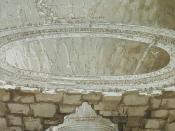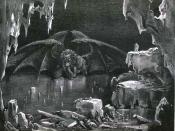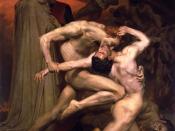Dante's Journey through the Nine Circles of Hell
Dante's Hell is based on a law of symbolic retribution - the talion or "divine justice." Dante believes that the world, including art, is created by the "divine word," and that all meaning ultimately comes from God. The Divine Comedy is a narrative poem describing Dante's imaginary journey. Midway on our life's journey, I found myself in dark woods, the right road lost. (Dante 1.1-2). Midway on his journey through life Dante realizes he has taken the wrong path. The Roman poet Virgil searches for the lost Dante at the request of Beatrice; he finds Dante in the woods on the evening of Good Friday in the year 1300 and serves as a guide as Dante begins his religious pilgrimage to find God. To reach his goal, Dante passes through Hell, Purgatory, and Paradise. The Divine Comedy was not titled as such by Dante; his title for the work was simply Commedia or Comedy.
Dante's use of the word "comedy" is medieval by definition. To Dante and his contemporaries, the term "comedy" meant a tale with a happy ending, not a funny story as the word has since come to mean. The Divine Comedy is made up of three parts, corresponding with Dante's three journeys: Inferno, or "Hell"; Purgatorio, or "Purgatory"; and Paradiso, or "Paradise." Each part consists of a prologue and approximately 33 cantos. Since the narrative poem is in an exalted form with a hero as its subject, it is an epic poem. Dante and Virgil enter the wide gates of Hell and descend through the nine circles of Hell. In each circle they see sinners being punished for their sins on earth; Dante sees the torture as Divine justice. The sinners in the circles include: Circle One - Those...


